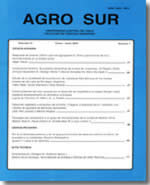Effect of steam flaking on ruminal degradability of corn grain
Main Article Content
Abstract
With the objective of estimating the effect of steam flaking of corn grain on its rumen degradability and degradation kinetics, samples of grain either ground (control) or steam rolled whole (HVE) or steam rolled ground (HVM), were subjected to seriated (0 to 48 h) rumen fermentations by the in situ technique with polyester bags. When fitting dry matter disappearance values to the function from Orskov and McDonald (1979) to estimate the terms representing the soluble fraction (a), insoluble degradable fraction (b) and the fractional degradation rate (c), the control treatment showed a lower "a" fraction (26.18%) than HVE (28%) and HVM (33.16%). Control treatment also presented a higher "b" fraction (72.02%) than HVE (53.94%) and HVM (54.82%), a lower "c" degradation rate (0.0419) than HVE (0.0863) and HVM (0.0768), and a higher potential degradation "a+b" (98.2%) than HVE (81.94%) and HVM (87.98%). Effective degradabilities computed for different ruminal fractional outflow rates (from 0.04 to 0.1) were higher with steam rolled treatments and moreover, increasing of the outflow rate resulted in less severe reductions in effective degradability for these treatments in relation to control. It is concluded that treating corn grain with temperature and high pressure steam, followed by rolling, results in an increased rate of energy supply at rumen level.

